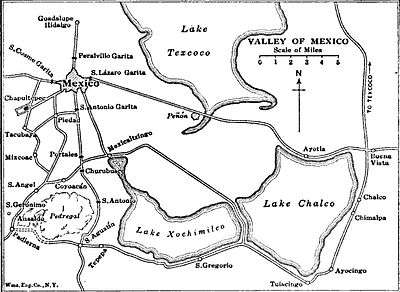Battle of Contreras
| Battle of Contreras | |||||||
|---|---|---|---|---|---|---|---|
| Part of the Mexican-American War | |||||||
 "The Battle of Contreras" by Carl Nebel. Oil on canvas, 1851. | |||||||
| |||||||
| Belligerents | |||||||
|
|
| ||||||
| Commanders and leaders | |||||||
|
|
| ||||||
| Strength | |||||||
| 10,738[2]:274 | 7,000[2]:291 | ||||||
| Casualties and losses | |||||||
| 60 killed or wounded[2]:295 |
~700 killed 1,224 wounded 843 captured[2]:295 | ||||||
| ||||||
| ||||||


The Battle of Contreras, also known as the Battle of Padierna, took place on 19–20 August 1847, in the final encounters of the Mexican-American War. In the Battle of Churubusco, fighting continued the following day.
Background
Leaving Puebla on 7 Aug. for his march on Mexico City, the U.S. army under Major General Winfield Scott, reached Ayotla and Chalco on 11 Aug. with the divisions of David E. Twiggs, William J. Worth, John A. Quitman, and Gideon Johnson Pillow.[2]:274 Scott moved on the south side of Lake Chalco on 15 Aug., advancing to San Agustin.[2]:290 Santa Anna had about 30,000 men defending the city, including 7,000 from Gabriel Valencia's Army of the North, which was located near Contreras by 17 Aug.[2]:291
Battle
Intending to flank San Antonio, Scott ordered Capt. Robert E. Lee to build a road across the Pedregal lava field so he could enfilade San Antonio to the north of San Agustin.[2]:292 On the morning on 19 Aug., Lee's men met Mexican pickets, which Major William W. Loring's companies cleared at Padierna, only to come under fire from Valencia's 22 pieces of artillery west of the Pedregal and north of Contreras.[2]:292 Pillow then brought in his artillery, under the command of Capt. John B. Magruder, Lt. Franklin D. Callender, and Lt. Jesse L. Reno.[2]:292 When told of the American movement across the Pedregal, Valencia exclaimed, "No! No! You're dreaming, man."[2]:292 In the mean time Col. Truman B. Ransom's 9th Infantry and Lt. Col. Milledge L. Bonham's 12th moved forward on the American right to within 200 yards of Valencia's camp by nightfall.[2]:292 Pillow also sent General Bennet Riley's brigade, supported by General George Cadwalader, to seize San Geronimo just north of Valencia's camp, while Persifor Smith's brigade, supported by General Franklin Pierce, struck Valencia from the front.[2]:293 Scott sent General James Shields brigade to Pillow who sent it after Cadwalader.[2]:293 Santa Anna moved with Brigadier General Francisco Perez's 3,000 man brigade to San Angel, just north of the fighting.[2]:293 Night brought a cold rain and the end of fighting for the day.[2]:294
During the night, Lt. Zealous Bates Tower discovered a ravine running southwest from San Geronimo to the rear of Valencia's camp, which Smith planned to use for a dawn attack the next morning.[2]:294 Lee volunteered to cross the Pedregal during the night so Scott could coordinate a diversion using Twiggs.[2]:294 Twiggs did so at 5 AM, just as Smith struck Valencia from the rear.[2]:295
Within seventeen minutes, Valencia and his force fled to San Angel.[2]:295
Aftermath
With the rout of Valencia, Santa Anna ordered Major General Nicolás Bravo at San Antonio and Brigadier General Antonio Gaona at Mexicalzingo both to fall back to Churubusco, where soon the Battle of Churubusco would commence.[2]:296
The U.S. forces captured 22 pieces of artillery and four generals.[2]:295
Scott commended Lee, who made three night crossings across the Pedregal, stating it was "the greatest feat of physical and moral courage performed by any individual" during the campaign,[2]:294 and awarded Lee with a brevet rank of lieutenant colonel.[4]
The battle culminated at the outskirts of Mexico City, at Padierna, among the neighborhoods of San Ángel, Contreras, and Tlalpan. (This area today is in the area between San Jerónimo, the neighborhood Heroes of Padierna, Anzaldo Dam in the periphery, and the part of Mexico City that today is ironically called "Placid Gardens".)
Partial Mexican Order of Battle
Division of the North - General of division Valencia
- Engineers - Gen. Jose M. Gonzalez de Mendoza
- Padierna rancho - Capt. Solis - pickets of infantry and cavalry
- 1st Line Infantry (Col? N. Mendoza)
- left - San Luis Potosí Battalion
- right - Infantry Brigade - Lt. Col. Cabrera-Celaya, Guanajuato and Querétaro Auxiliaries and Activos
- Artillery reserve - Gen. F. Mejia
- second line - 10th and 12th Line, Fijo of Mexico and Tampico Garda Costa Infantry
- Anzaldo - Reserves - Gen. Salas - Sappers, Mixto de Santa Ana and Aguascalientes Infantry; 2nd, 3rd, and 8th Line Cavalry and Guanajuato Activos
- right - 7th and San Luis Cavalry
- bridge - Torrejon Cavalry Brigade, Fabriquita-Romero Brigade
References
- ↑ http://www.casaimperial.org/principe_es.htm
- 1 2 3 4 5 6 7 8 9 10 11 12 13 14 15 16 17 18 19 20 21 22 23 Bauer, K.J., 1974, The Mexican War, 1846-1848, New York:Macmillan, ISBN 0803261071
- 1 2 Smith, J.H., 1919, The War with Mexico, New York: Macmillan
- ↑ Davis, Jefferson. Edited by Colonel Harold B. Simpson. Robert E. Lee The Hill Junior College Press. Hillsboro, Texas. 1960.
Additional Reading
- Gen. Winfield Scott's official report of the battle
- Alcara, Ramon et al. Apuntes Para la Historia de la Guerra entre Mexico y los Estados Unidos Mexico City.
- Frías, Heriberto. La batalla de Padierna
- Nevin, David (editor). The Mexican War (1978)
- Prieto, Guillermo. Apuntes históricos
- Ramsey, Albert C. The Other Side New York, John Wiley, 1850.
External links
- "A Continent Divided: The U.S. - Mexico War", Center for Greater Southwestern Studies, the University of Texas at Arlington